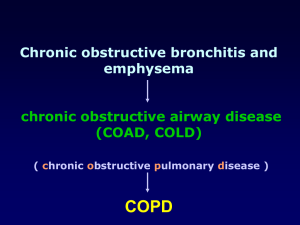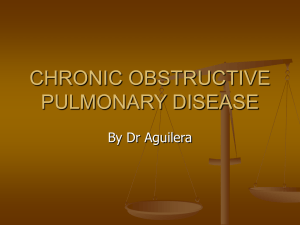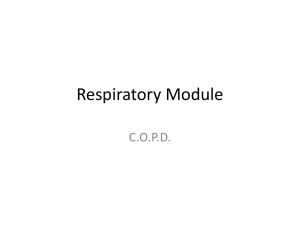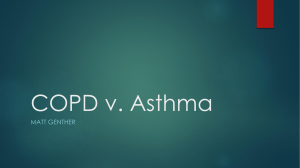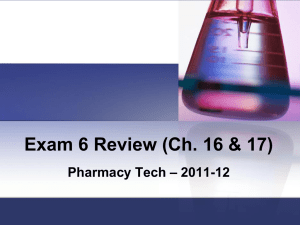Emphysema and Chronic Bronchitis
advertisement
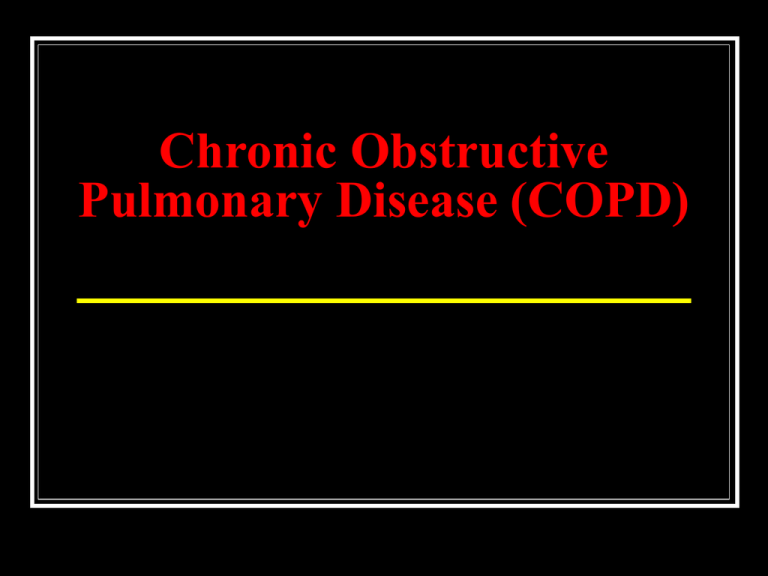
Chronic Obstructive Pulmonary Disease (COPD) COPD Description Characterized by presence of airflow obstruction Caused by emphysema or chronic bronchitis Generally progressive May be accompanied by airway hyperreactivity May be partially reversible Emphysema Description Abnormal permanent enlargement of the air space distal to the terminal bronchioles Accompanied by destruction of bronchioles Chronic Bronchitis Description Presence of chronic productive cough for 3 or more months in each of 2 successive years in a patient whom other causes of chronic cough have been excluded COPD Causes Cigarette smoking Primary cause of COPD*** Clinically significant airway obstruction develops in 15% of smokers 80% to 90% of COPD deaths are related to tobacco smoking > 1 in 5 deaths is result of cigarette smoking COPD Causes Cigarette smoking Nicotine stimulates sympathetic nervous system resulting in: HR Peripheral vasoconstriction BP and cardiac workload COPD Causes Cigarette smoking Compounds problems in a person with CAD Ciliary activity Possible loss of ciliated cells Abnormal dilation of the distal air space Alveolar wall destruction Carbon monoxide O2 carrying capacity Impairs psychomotor performance and judgment Cellular hyperplasia Production of mucus Reduction in airway diameter Increased difficulty in clearing secretions COPD Causes Secondhand smoke exposure associated with: Pulmonary function Risk of lung cancer Mortality rates from ischemic heart disease COPD Causes Infection Major contributing factor to the aggravation and progression of COPD Heredity -Antitrypsin (AAT) deficiency (produced by liver and found in lungs); accounts for < 1% of COPD cases Emphysema results from lysis of lung tissues by proteolytic enzymes from neutrophils and macrophages Pathophysiology of Chronic Bronchitis and Emphysema Fig. 28-7 Emphysema Pathophysiology Hyperinflation of alveoli Destruction of alveolar walls Destruction of alveolar capillary walls Narrowed airways Loss of lung elasticity Emphysema Pathophysiology Two types: Centrilobular (central part of lobule) Most common Panlobular (destruction of whole lobule) Usually associated with AAT deficiency Emphysema Pathophysiology Structural changes are: Hyperinflation of alveoli Destruction of alveolar capillary walls Narrowed, tortuous small airways Loss of lung elasticity Emphysema Pathophysiology Small bronchioles become obstructed as a result of Mucus Smooth muscle spasm Inflammatory process Collapse of bronchiolar walls Recurrent infections production/stimulation of neutrophils and macrophages release proteolytic enzymes alveolar destruction inflammation, exudate, and edema Emphysema Pathophysiology Elastin and collagen are destroyed Air goes into the lungs but is unable to come out on its own and remains in the lung Causes bronchioles to collapse Emphysema Pathophysiology Trapped air hyperinflation and overdistention As more alveoli coalesce, blebs and bullae may develop Destruction of alveolar walls and capillaries reduced surface area for O2 diffusion Compensation is done by increasing respiratory rate to increase alveolar ventilation Hypoxemia usually develops late in disease Emphysema Clinical Manifestations Dyspnea Progresses in severity Patient will first complain of dyspnea on exertion and progress to interfering with ADLs and rest Emphysema Clinical Manifestations Minimal coughing with no to small amounts of sputum Overdistention of alveoli causes diaphragm to flatten and AP diameter to increase Emphysema Clinical Manifestations Patient becomes chest breather, relying on accessory muscles Ribs become fixed in inspiratory position Emphysema Clinical Manifestations Patient is underweight (despite adequate calorie intake) Chronic Bronchitis Pathophysiology Pathologic lung changes are: Hyperplasia of mucus-secreting glands in trachea and bronchi Increase in goblet cells Disappearance of cilia Chronic inflammatory changes and narrrowing of small airways Altered fxn of alveolar macrophages infections Chronic Bronchitis Pathophysiology Chronic inflammation Primary pathologic mechanism causing changes Narrow airway lumen and reduced airflow d/t hyperplasia of mucus glands Inflammatory swelling Excess, thick mucus Chronic Bronchitis Pathophysiology Greater resistance to airflow increases work of breathing Hypoxemia and hypercapnia develop more frequently in chronic bronchitis than emphysema Chronic Bronchitis Pathophysiology Bronchioles are clogged with mucus and pose a physical barrier to ventilation Hypoxemia and hypercapnia d/t lack of ventilation and O2 diffusion Tendency to hypoventilate and retain CO2 Frequently patients require O2 both at rest and during exercise Chronic Bronchitis Pathophysiology Cough is often ineffective to remove secretions because the person cannot breathe deeply enough to cause air flow distal to the secretions Bronchospasm frequently develops More common with history of smoking or asthma Chronic Bronchitis Clinical Manifestations Earliest symptoms: Frequent, productive cough during winter Frequent respiratory infections Chronic Bronchitis Clinical Manifestations Bronchospasm at end of paroxysms of coughing Cough Dyspnea on exertion History of smoking Normal weight or heavyset Ruddy (bluish-red) appearance d/t polycythemia (increased Hgb d/t chronic hypoxemia)) cyanosis Chronic Bronchitis Clinical Manifestations Hypoxemia and hypercapnia Results from hypoventilation and airway resistance + problems with alveolar gas exchange COPD Complications Pulmonary hypertension (pulmonary vessel constriction d/t alveolar hypoxia & acidosis) Cor pulmonale (Rt heart hypertrophy + RV failure) Pneumonia Acute Respiratory Failure COPD Diagnostic Studies Chest x-rays early in the disease may not show abnormalities History and physical exam Pulmonary function studies reduced FEV1/FVC and residual volume and total lung capacity COPD Diagnostic Studies ABGs PaO2 PaCO2 (especially in chronic bronchitis) pH (especially in chronic bronchitis) Bicarbonate level found in late stages COPD COPD Collaborative Care Smoking cessation Most significant factor in slowing the progression of the disease COPD Collaborative Care: Drug Therapy Bronchodilators – as maintenance therapy -adrenergic agonists (e.g. Ventolin) MDI or nebulizer preferred Anticholinergics (e.g. Atrovent) COPD Collaborative Care: Oxygen Therapy O2 therapy Raises PO2 in inspired air Treats hypoxemia Titrate to lowest effective dose COPD Collaborative Care: Oxygen Therapy Chronic O2 therapy at home Improved prognosis Improved neuropsychologic function Increased exercise tolerance Decreased hematocrit Reduced pulmonary hypertension COPD Collaborative Care: Respiratory Therapy Breathing retraining Pursed-lip breathing Prolongs exhalation and prevents bronchiolar collapse and air trapping Diaphragmatic breathing Focuses on using diaphragm instead of accessory muscles to achieve maximum inhalation and slow respiratory rate See text re how to teach COPD Collaborative Care: Respiratory Therapy Huff coughing (Table 28-21) Chest physiotherapy – to bring secretions into larger, more central airways Postural drainage Percussion Vibration Positions for Postural Positions for Postural Drainage Drainage Fig. 28-16 COPD Collaborative Care Encourage as possible patient to remain as active COPD Collaborative Care Surgical Therapy Lung volume reduction surgery Lung transplant COPD Collaborative Care Nutritional therapy Full stomachs press on diaphragm causing dyspnea and discomfort Difficulty eating and breathing at the same time leads to inadequate amounts being eaten COPD Collaborative Care Nutritional therapy To decrease dyspnea and conserve energy Rest at least 30 minutes prior to eating Use bronchodilator before meals Select foods that can be prepared in advance 5-6 small meals to avoid bloating Avoid foods that require a great deal of chewing Avoid exercises and treatments 1 hour before and after eating COPD Collaborative Care Nutritional therapy Avoid gas-forming foods High-calorie, high-protein diet is recommended Supplements Avoid high carbohydrate diet to prevent increase in CO2 load Nursing Management Nursing Diagnoses Ineffective airway clearance Impaired gas exchange Imbalanced nutrition: less than body requirements Disturbed sleep pattern Risk for infection Nursing Management Nursing Implementation Health Promotion STOP SMOKING!!! Avoid or control exposure to occupational and environmental pollutants and irritants Early detection of small-airway disease Early diagnosis of respiratory tract infections Nursing Management Nursing Implementation Acute Intervention Required for complications like pneumonia, cor pulmonale, and acute respiratory failure Nursing Management Nursing Implementation Ambulatory and Home Care Pulmonary rehabilitation Control and alleviate symptoms of pathophysiologic complications of respiratory impairment Nursing Management Nursing Implementation Ambulatory and Home Care Teach patient how to achieve optimal capability in carrying out ADLs Physical therapy Nutrition Education Activity considerations Exercise training of upper extremities to help improve function and relieve dyspnea Nursing Management Nursing Implementation n n Ambulatory and Home Care Explore alternative methods of ADLs Encourage patient to sit while performing activities Coordinated walking Nursing Management Nursing Implementation Ambulatory and Home Care Slow, pursed-lip breathing After exercise, wait 5 minutes before using -adrenergic agonist MDI Nursing Management Nursing Implementation Ambulatory and Home Care Sexual activity Plan during part of day when breathing is best Slow, pursed-lip breathing Refrain after eating or other strenuous activity Do not assume dominant position Do not prolong foreplay Nursing Management Nursing Implementation Ambulatory and Home Care Sleep Nasal saline sprays Decongestants Nasal steroid inhalers Long-acting theophylline Decreases bronchospasm and airway obstruction Nursing Management Nursing Implementation Ambulatory and Home Care Psychosocial considerations Guilt Depression Anxiety Social isolation Denial Dependence Use relaxation techniques and support groups Nursing Management Nursing Implementation Ambulatory and Home Care Discourage moving to places above 4000 ft.
